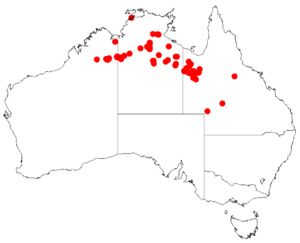Thomson's wattle facts for kids
Quick facts for kids Thomson's wattle |
|
|---|---|
 |
|
| Scientific classification | |
| Genus: |
Acacia
|
| Species: |
thomsonii
|
 |
|
| Occurrence data from AVH | |
Thomson's wattle, also known by its scientific name Acacia thomsonii, is a type of shrub or small tree. It belongs to the Acacia family, which is a large group of plants. You can find Thomson's wattle growing naturally in parts of northern Australia.
What Thomson's Wattle Looks Like
This plant is usually a thin shrub or small tree. It can grow to be about 2 to 6 metres (7 to 20 ft) tall.
Its leaves are actually special flattened stems called phyllodes. They are green to grey-green in color. These phyllodes are straight and often a little uneven in shape. They look like a narrow oval or a long, thin rectangle. Each phyllode is about 7.5 to 17 cm (3.0 to 6.7 in) long and 1 to 2 cm (0.39 to 0.79 in) wide. They have many fine lines, and usually three of these lines are easier to see than the others.
Thomson's wattle blooms with yellow flowers from June to August. The flowers grow in small clusters called inflorescences. These clusters are very tiny, only about 0.5 mm (0.020 in) long, and hold two flower heads. The flower spikes themselves are 15 to 30 mm (0.59 to 1.18 in) long.
After the flowers, the plant grows seed pods. These pods are long and straight, or sometimes slightly curved. They are about 4.5 to 8 cm (1.8 to 3.1 in) long and 3 to 4.5 mm (0.12 to 0.18 in) wide. Inside the pods, you'll find shiny black or brown seeds. The seeds are oblong, meaning they are longer than they are wide, and measure about 3 to 5 mm (0.12 to 0.20 in) long. Each seed has a bright yellow part attached to it, called an aril.
How Thomson's Wattle Got Its Name
This plant was officially described for the first time in 1996. Two botanists, Bruce Maslin and William McDonald, gave it its scientific name, Acacia thomsonii. They published their findings in a science journal called Nuytsia.
Later, in 2003, another botanist named Leslie Pedley reclassified it. He moved it to a different group, calling it Racosperma thomsonii. However, in 2006, it was moved back to the Acacia group, where it remains today.
Where Thomson's Wattle Grows
Thomson's wattle is found in several parts of northern Australia. In Western Australia, you can only find it in the Kimberley region. It also grows across the top end of the Northern Territory and in some areas of Western Queensland.
These plants often grow on rocky hills and flat areas with many small valleys. They can also be found on stony or sandy plains. Sometimes, they grow along small, spread-out water channels. They prefer thin, rocky, sandy soils that are a little bit acidic.

